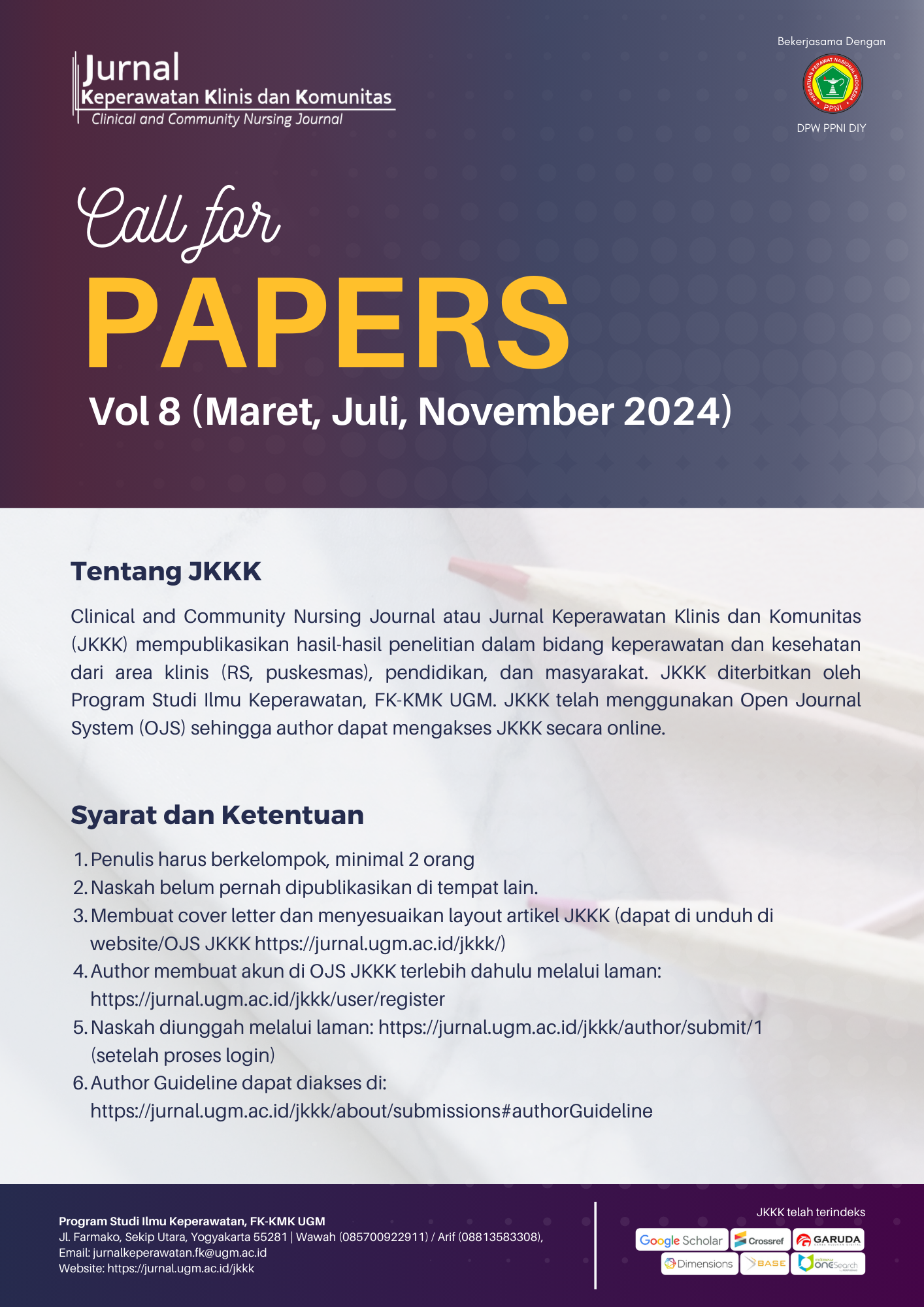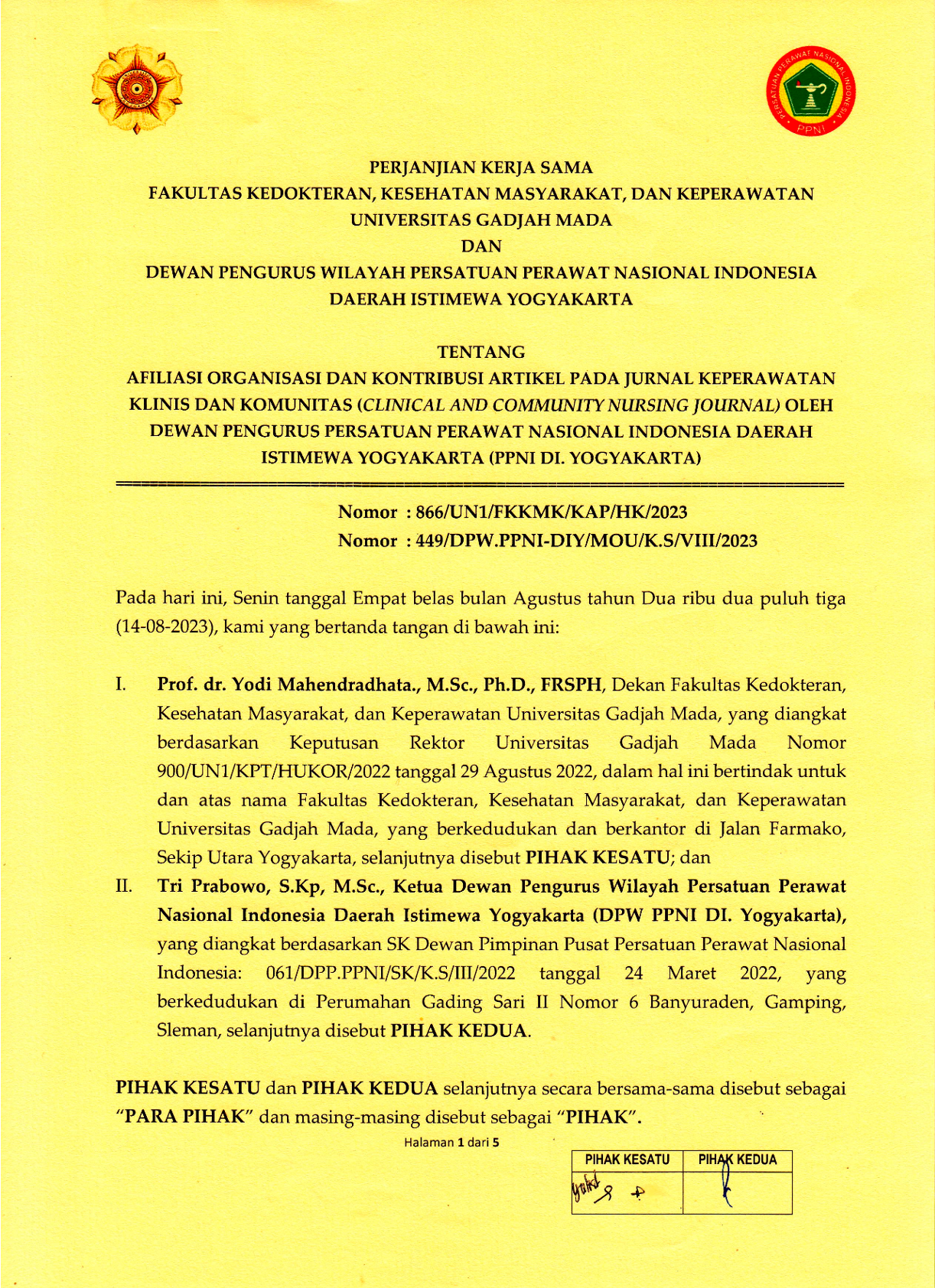Kepuasan Belajar Mahasiswa Keperawatan Terhadap Implementasi Flipped Classroom
Larissa Oktavia Syafri(1*), Totok Harjanto(2), Ariani Arista Putri Pertiwi(3)
(1) Program Studi Ilmu Keperawatan, Fakultas Kedokteran, Kesehatan Masyarakat, dan Keperawatan Universitas Gadjah Mada
(2) Departemen Keperawatan Dasar dan Emergensi, Fakultas Kedokteran, Kesehatan Masyarakat, dan Keperawatan Universitas Gadjah Mada
(3) Departemen Keperawatan Dasar dan Emergensi, Fakultas Kedokteran, Kesehatan Masyarakat, dan Keperawatan Universitas Gadjah Mada
(*) Corresponding Author
Abstract
Background: Nursing students are experiencing difficulties in understanding the material during clinical skills learning due to differences in content delivery among instructors. One possible solution is to implement the flipped classroom method, which can provide a more interactive learning approach. It is hoped that the implementation of this method will increase the level of student satisfaction in learning nursing skills.
Objective: To assess the satisfaction of nursing students regarding the implementation of flipped classroom in clinical skills learning in nursing.
Method: This study was quantitative descriptive research using a cross-sectional research design. 102 respondents of nursing students at Gadjah Mada University (UGM) of the first semester at the 2019/2020 academic year were selected using total sampling. The instrument used was the Collaborative Learning, Social Presence, and Satisfaction (CLSS) questionnaire. The data were analyzed using univariate analysis to describe the characteristics of the respondents and the variables under investigation.
Outcome: The satisfaction level of respondents regarding the implementation of the flipped classroom method was categorized as high, moderate, and low, with percentages of 42,2%, 56,9%, and 0,9%, respectively.
Conclusion: The level of satisfaction among nursing students at UGM regarding the implementation of the flipped classroom method was at the moderate range.
Latar belakang: Mahasiswa keperawatan mengalami kesulitan dalam memahami materi saat pembelajaran keterampilan klinis karena perbedaan penyampaian materi antar instruktur. Salah satu solusi yang dapat dilakukan adalah dengan menggunakan metode flipped classroom, yang dapat memberikan pendekatan pembelajaran yang lebih interaktif. Diharapkan tingkat kepuasan pembelajaran mahasiswa keperawatan dapat meningkat dengan adanya metode ini.
Tujuan: Untuk mengetahui gambaran kepuasan belajar mahasiswa keperawatan terhadap implementasi flipped classroom dalam pembelajaran keterampilan klinik keparawatan.
Metode: Penelitian deskriptif kuantitatif dengan desain penelitian cross sectional. Teknik pengambilan responden menggunakan total sampling dengan sampel sebanyak 102 mahasiswa keperawatan di Universitas Gadjah Mada (UGM) semester satu tahun ajaran 2019/2020. Instrumen yang digunakan adalah the collaborative learning, social presence, and satisfaction (CLSS) questionnaire. Analisis data yang dilakukan menggunakan analisis univariat untuk mendeskripsikan karakteristik responden dan variabel yang diteliti.
Hasil: Tingkat kepuasan responden terhadap implementasi flipped classroom berada pada kategori tinggi, sedang, dan rendah dengan persentase sebesar 42,2%, 56,9%, dan 0,9%.
Kesimpulan: Tingkat kepuasan mahasiswa keperawatan di UGM terhadap implementasi flipped classroom berada dalam rentang sedang.
Keywords
Full Text:
PDFReferences
- Aryanty N, Puspasari A, Purwakanthi A. Perbandingan efektivitas pembelajaran Clinical Skill Lab (CSL) dengan menggunakan video ajar keterampilan klinik neurologi terhadap demonstrasi oleh instruktur. JMJ. 2014; 2(2): 189–196.
- Kementerian Pendidikan dan Kebudayaan. Panduan penyusunan kurikulum pendidikan tinggi di era industri 4.0 [homepage on the internet]. c2020. Available form: https://dikti.kemdikbud.go.id/wp-content/uploads/2020/10/BUKU-PANDUAN-PENYUSUNAN-KURIKULUM-PENDIDIKAN-TINGGI-MBKM.pdf
- Hessler KL. Nursing education: flipping the classroom. the Nurse Practitioner. 2016; 41(2): 17-27.
- Critz CM & Knight D. Using the flipped classroom in graduate nursing education. Nurse Educator. 2013; 38(5): 210-213.
- Jung H & Park KH. Analysis of satisfaction and academic achievement of medical students in a flipped class. Korean Journal of Medical Education. 2018; 30(2): 101-107.
- Yacout, Shosha A. Nursing students’ perception towards flipped classroom educational strategy. Journal of America Science. 2016; 12(2): 62-75.
- Mikkelsen TR. Nursing students’ experiences, perceptions and behavior in a flipped-classroom anatomy and physiology course. Journal of Nursing Education and Practice. 2015; 5(10): 28-35.
- Hung HT. flipping the classroom for English language learners to foster active learning. Computer Assisted Language Learning. 2015; 28(1): 81–96.
- Domínguez LC, Sierra D, Pepín J, Moros G, Villarraga A. Effect of the extended inverted classroom on clinical simulation for the resuscitation of trauma patients: pilot study of student perceptions of learning. Colombian Journal of Anesthesiolog. 2017; 45: 4-11.
- Hyo, Brush. Student perceptions of collaborative learning, social presence and satisfaction in a blended learning environment: Relationships and critical factors. Computers & Education. 2008; 51: 318-336.
- Charlotte N, Gunawardena, Frank J. Zittle. Social presence as a predictor of satisfaction within a computer-mediated conferencing environment, American Journal of Distance Education. 1997; 11(3): 8-26.
- Folami FF. Gender inequality and role-strained among male nursing students in selected nursing institution, Lagos, Nigeria. journal of education and training studies. 2017; 5(6): 214-219.
- Latifah L, Anggraeni MD. Pengalaman mahasiswa pria dalam praktek profesi keperawatan maternitas yang bias gender. Jurnal Keperawatan Soedirman. 2014; 9(3): 146-155.
- Suharyanto S, Mailangkay A. Penerapan e-learning sebagai alat bantu mengajar dalam dunia pendidikan. Jurnal Ilmiah Widya. 2016; 3(4): 17-21.
- Abou El-Seoud M, Taj-Eddin I, Seddiek N, El-Khouly M, Nosseir A. E-Learning and students’ motivation: a research study on the effect of e-learning on higher education. International Journal of Emerging Technologies in Learning (iJET). 2014; 9(4): 20-26.
- Koo CL, Demps EL, Farris C, Bowman JD, Panahi L, Boyle P. Impact of flipped classroom design on student performance and perceptions in a pharmacotherapy course. American journal of pharmaceutical education. 2016; 80(2): 1-9.
- Food and Agriculture Organization of the United Nations. E-learning methodologies: A guide for designing and developing e-learning courses [homepage on the internet]. c2021. Available from: https://www.fao.org/3/i2516e/i2516e.pdf
- Hurst KM. Using video podcasting to enhance the learning of clinical skills: A qualitative study of physiotherapy students’ experiences. Nurse Education Today. 2016; 45: 206-211.
- Chen Y, Wang Y, Kinshuk, Chen NS. Is FLIP enough? Or should we use the FLIPPED model instead? Computers & Education. 2014; 79: 16–27.
- Appleton-Knapp SL, Krentler KA. Measuring student expectations and their effects on satisfaction: the importance of managing student expectations. Journal Of Marketing Education. 2006; 28(3): 254-264.
- Talan T, Gulsecen S. The effect of a flipped classroom on students’ achievements, academic engagement and satisfaction levels. Turkish Online Journal of Distance Education. 2019; 20(4): 31-60.
- Topala I, Tomozii S. Learning satisfaction: Validity and reliability testing for Students’ Learning Satisfaction Quetionnaire (SLSQ). Procedia – Social and Behavioral Sciences. 2014; 128: 380-386.
- Missildine K, Fountain R, Summers L, Gosselin K. Flipping the classroom to improve student performance and satisfaction. Journal of Nursing Education. 2013; 52(10): 597-599.
Article Metrics
Refbacks
- There are currently no refbacks.
Copyright (c) 2020 Larissa Oktavia Syafri, Totok Harjanto, Ariani Arista Putri Pertiwi

Jurnal Keperawatan Klinis dan Komunitas (Clinical and Community Nursing Journal)
collaborates with DPW PPNI DIY
![]()
Jurnal Keperawatan Klinis dan Komunitas (Clinical and Community Nursing Journal) is licensed under a Creative Commons Attribution-ShareAlike 4.0 International License.





